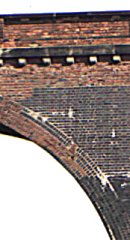
 This is Europes largest brick-built structure. It stands about twenty miles from the Midlands city in which I live. It is close to a mile in length, it has 82 arches, and contains about 20 million bricks. Amazingly only a tiny number of the city's quarter million inhabitants have ever seen it, and very few even know of its existence. It is a truly awesome human endeavour; why therefore is it so little known?
One very good reason for this ignorance is that it's almost impossible to do it justice in a single photograph, showing all the arches. You need a rotating panoramic camera with a very long-focus lens and then you’ve got to find the one square yard of ground to pitch a tripod which gives the optimum view. I wanted all that and more :I wanted to delineate as many individual bricks as possible on a single image. The only way to capture that was to use a giant camera designed in 1903 and a piece of film measuring almost 900 square inches. The snag is that I have not yet managed to find a way of showing the result which reaches a wide audience. It has been used in Art exhibitions but these have a very small public: the perception has grown up that still photographs can be made to fit all forms of mass media. But the image seen here, which is fifteen times longer than its height, does not sit meaningfully on a television screen, or a magazine page, or even a very long postcard. So to many people it remains unknown. The only public place where you can see it at present is on a corridor in the Radcliffe Infirmary in Oxford. This is a contact-print on archival Cibachrome material; subsequently I made another one for a well-known Hollywood film director and then a few more for private collectors.This website is about other similar images, too large and detailed for media use, which languish unseen except as fine-art objects in collections; some of them depict subjects which cannot be conventionally photographed, or subjects which can never be rephotographed even though they still exist.
This is Europes largest brick-built structure. It stands about twenty miles from the Midlands city in which I live. It is close to a mile in length, it has 82 arches, and contains about 20 million bricks. Amazingly only a tiny number of the city's quarter million inhabitants have ever seen it, and very few even know of its existence. It is a truly awesome human endeavour; why therefore is it so little known?
One very good reason for this ignorance is that it's almost impossible to do it justice in a single photograph, showing all the arches. You need a rotating panoramic camera with a very long-focus lens and then you’ve got to find the one square yard of ground to pitch a tripod which gives the optimum view. I wanted all that and more :I wanted to delineate as many individual bricks as possible on a single image. The only way to capture that was to use a giant camera designed in 1903 and a piece of film measuring almost 900 square inches. The snag is that I have not yet managed to find a way of showing the result which reaches a wide audience. It has been used in Art exhibitions but these have a very small public: the perception has grown up that still photographs can be made to fit all forms of mass media. But the image seen here, which is fifteen times longer than its height, does not sit meaningfully on a television screen, or a magazine page, or even a very long postcard. So to many people it remains unknown. The only public place where you can see it at present is on a corridor in the Radcliffe Infirmary in Oxford. This is a contact-print on archival Cibachrome material; subsequently I made another one for a well-known Hollywood film director and then a few more for private collectors.This website is about other similar images, too large and detailed for media use, which languish unseen except as fine-art objects in collections; some of them depict subjects which cannot be conventionally photographed, or subjects which can never be rephotographed even though they still exist.
